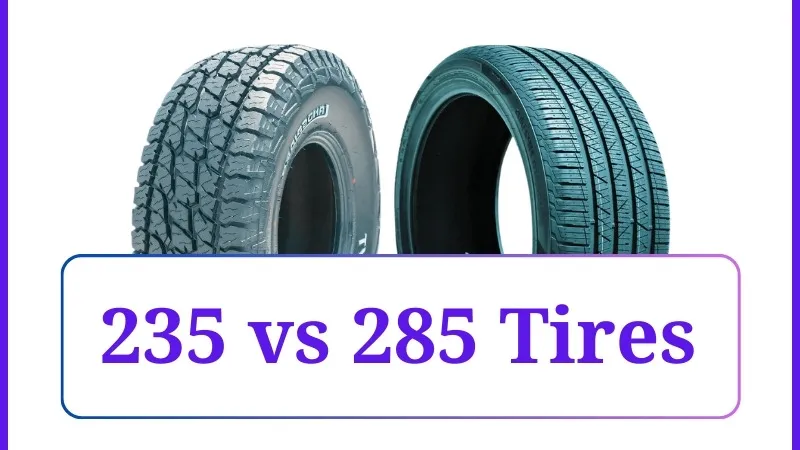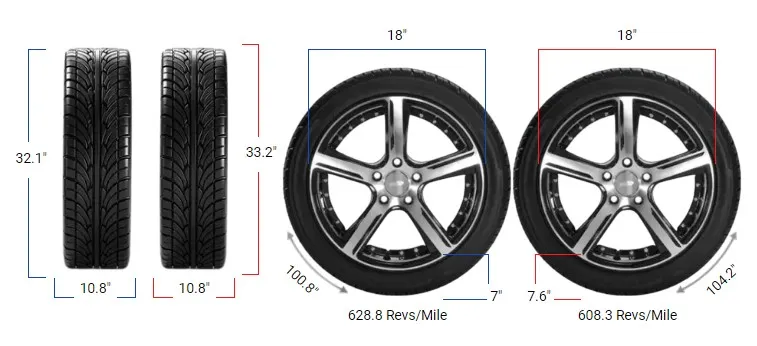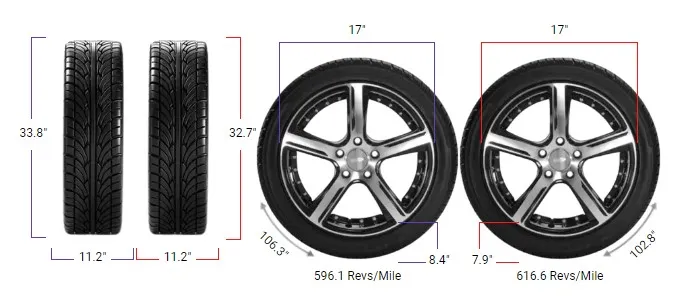235 vs 285 Tires

Selecting the correct tire size plays a significant role in determining your vehicle’s overall performance, safety, and comfort. The main difference between 235 and 285 tires lies in their width.
The 285 tires is about 50 mm wider than the 235 tires. This increase in width affects various aspects of vehicle performance, such as traction, handling, fuel efficiency, and comfort.
With 285 tires, you get a significantly wider contact patch, which enhances grip and stability, especially during high-speed cornering or off-road driving.
This increased width makes 285 tires a popular choice for trucks and SUVs used in demanding conditions. In contrast, 235 tires provide a more balanced approach, offering adequate traction while being more efficient and practical for everyday driving, especially for sedans and light-duty SUVs.

Fitment Guide
The Ideal Rim Width Range must overlap to ensure proper fitment. In this case, there is no overlap between the rim width ranges of 235 and 285 tires, making it impractical to switch without also changing the rims.
- 235 tire: Compatible with rims that are 7.0 to 8.5 inches wide.
- 285 tire: Suitable for rims ranging from 9.5 to 11.0 inches wide.
On-Road Performance
285 tires offer improved stability and traction due to their wider contact area, making them ideal for high-speed driving and cornering. The additional width provides increased grip, which can be especially beneficial on winding roads or during sudden maneuvers. Drivers seeking enhanced stability and confident cornering will appreciate the performance benefits of 285 tires.
On the other hand, 235 tires offer a more agile driving experience, particularly in urban settings. The narrower profile allows for lighter steering and improved maneuverability, which can make a difference in tight spaces or when parking. This makes 235 tires a more practical choice for daily commuting and city driving, where responsiveness is more critical than maximum traction.
Fuel Efficiency: 235 tires have the advantage when it comes to fuel efficiency. The narrower profile means less rolling resistance, which reduces the energy required to maintain speed. As a result, 235 tires can help improve fuel economy, making them a cost-effective option for long commutes and highway driving.

In contrast, 285 tires provide better traction but at the cost of increased rolling resistance, which can lead to higher fuel consumption. For drivers who prioritize performance over fuel savings, the trade-off may be worthwhile, but it’s an important consideration for those looking to keep running costs low.
Ride Comfort: When it comes to ride comfort, 235 tires often provide a smoother experience for everyday driving. The narrower width allows the tire to absorb road imperfections more effectively, resulting in a less bumpy ride and reduced road noise. This makes 235 tires a good choice for those who value comfort and a quiet cabin.
285 tires, while offering enhanced stability, may provide a firmer ride due to the increased contact area and stiffer sidewalls. This can lead to more road noise and less comfort on uneven surfaces. However, for those who prioritize performance and stability, the firmer ride may be a small price to pay.
Off-Road Performance
For off-road enthusiasts, 285 tires are generally the superior choice. The wider contact patch provides better flotation on loose surfaces like gravel, sand, and mud, reducing the risk of getting stuck and improving stability on uneven terrain.

This makes 285 tires a preferred option for trucks and SUVs used for off-road adventures. 235 tires are capable of handling light off-road conditions, but their narrower profile means they may struggle to maintain grip on loose or uneven surfaces.
While 235 tires are versatile enough for occasional off-road use, they are not designed for demanding off-road environments like 285 tires are.
Speedometer Impact
Switching between 235 and 285 tires can affect your vehicle’s speedometer and odometer accuracy. A change in overall diameter can lead to discrepancies in speed and distance readings. For example, a larger overall diameter may cause the speedometer to underreport your actual speed, while a smaller diameter may lead to overreporting.
To maintain accurate speed and distance measurements, it may be necessary to recalibrate the speedometer if the difference in overall diameter exceeds 3%. Proper calibration is essential to ensure reliable performance metrics and to maintain safety while driving.

Benefits of 285 Tires:
- Enhanced Traction and Stability: The wider contact area offers improved grip, especially in high-speed and off-road conditions.
- Aggressive Aesthetic: 285 tires give vehicles a more rugged and aggressive look, which can be appealing for performance enthusiasts.
- Better Off-Road Capability: The larger footprint provides better flotation on loose surfaces, making 285 tires ideal for off-road driving.
Drawbacks of 285 Tires:
- Lower Fuel Efficiency: The increased rolling resistance of 285 tires can lead to reduced fuel efficiency, particularly in city driving.
- Firmer Ride: The wider profile may contribute to a firmer ride, which can be less comfortable for those prioritizing a smooth driving experience.
Benefits of 235 Tires:
- Better Fuel Economy: The narrower width reduces rolling resistance, resulting in improved fuel efficiency, making 235 tires ideal for long-distance driving.
- Easier Handling: The lighter steering effort makes 235 tires easier to maneuver, particularly in urban environments.
- Quieter Ride: The reduced contact patch helps minimize road noise, contributing to a quieter and more comfortable driving experience.
Drawbacks of 235 Tires:
- Limited Traction: Compared to 285 tires, 235 tires have a smaller contact area, which can reduce traction, especially in off-road or wet conditions.
- Less Aggressive Appearance: 235 tires may not provide the same bold look as 285 tires, which can be important for those seeking a sportier aesthetic.

Difference Between 235 and 285 Tires
The primary difference between 235 and 285 tires is their width: 235 mm versus 285 mm, making the 285 tire significantly wider. Their ideal rim width ranges do not overlap, meaning a swap between these sizes is not feasible under standard conditions.
Can I Use 235 Tires Instead of 285?
No, you cannot use 235 tires instead of 285 tires because their ideal rim width ranges do not overlap. This lack of compatibility could lead to issues with performance, safety, and comfort, and thus, switching is not recommended.
Can I Use 285 Tires Instead of 235?
No, using 285 tires instead of 235 tires is not recommended due to the lack of overlap in their ideal rim width ranges. This mismatch may compromise vehicle handling, safety, and overall driving comfort, making such a switch impractical.
Can You Put 235 Tires on 285 Rims?
No, you cannot mount 235 tires on rims designed for 285 tires because their ideal rim width ranges do not overlap. Using mismatched tires and rims may result in unsafe driving conditions and poor handling.
Can You Put 285 Tires on 235 Rims?
No, putting 285 tires on rims meant for 235 tires is not feasible as their ideal rim width ranges do not overlap. This incompatibility could compromise vehicle safety and handling, and thus, such a swap is not advisable.
Our Observation
Choosing between 235 and 285 tires involves understanding the trade-offs in terms of performance, comfort, and fuel efficiency.
235 tires are well-suited for those seeking practicality, comfort, and fuel savings, while 285 tires are ideal for drivers seeking enhanced stability, off-road capabilities, and a more aggressive aesthetic.
Consulting a tire professional is always recommended to ensure that your chosen tire size is compatible with your vehicle and meets your specific driving requirements.



